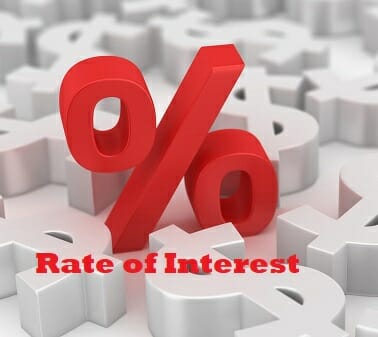Financial Terms | How Rate of Interest (Interest Rate) is Calculated ?
What is Rate of Interest (Interest Rate) and How Rate of Interest is Calculated? But First, do you know what exactly is Interest?
Rate of Interest (Interest Rate) is a Fee which we either Pay in case of Loan or Income we receive in case of any investment like FD or Debt instrument etc. Both Loans and Deposits are linked to a particular Rate of Interest (Interest Rate).
Rate of Interest (Interest Rate) is also called as ROI.
The Rate of Interest or interest rate is a generic notion that it is usually associated to Loans or Deposits like Fixed deposit etc. In other words, It will indicate the amount that a lender charges to the borrower in exchange for the Money given as Loan. It is expressed as a percentage of this amount (principal). Similarly for Deposits, the fixed percentage on deposited amount given as Interest determines the Rate of Interest on Deposits.
Rate of Interest (Interest Rate) is generally calculated on Annual or Per Annum Basis. Like 5% Rate of Interest Per Annum. Similarly it can be Quarterly or Half yearly also, But Knowing Rate of Interest without the duration is incomplete study.
For Example- 5% Rate of Interest Per Annum on Housing Loan or 8% Interest on Fixed Deposits Annually.

In case of Loans | How Rate of Interest is Calculated ?
So For Loans, To calculate Rate of Interest, You need to know –
- Amount of Interest – I, Lets take I as 5000
- Annually or Quarterly or Monthly – A, Lets take it Annually so 1
- Borrowed Money – B, Lets take B as 100000
Now Putting it in the formula –
Rate of Interest = (I / B)*100
i.e. (5000/100000)*100 = 5%
Now , This is an Annual Rate of Interest, If you need to convert it to –
– Monthly, Divide it by A i.e. 12,
– Quarterly, Divide it by A i.e. 4
Fixed Rate of Interest V/s Variable Rate of Interest
Fixed Rate of Interest as the name suggests, its a simplest form of Interest which doesn’t change across the tenure of Loan. It states that at the time of Loan agreement, if let say 5% is decided as the interest per annum for 10 years, so across this 10 year term, your rate of interest will be FIXED as 5% only and will not change even of the rate of interest prevailing after 10 years to new customer may be like 7% or 8%. Means, the cost of fund changes every year and basis which, bank reserves the right to change the rate of interest, it can go up and go down as well, but in case of FIXED INTEREST, IT DOESN’T CHANGE.
Variable Rate of Interest on the other hand doesn’t guarantee any Fixed interest and hence can change accordingly. So this rate of interest fluctuates depending upon the various factors. Hence in Variable Rate of Interest, your EMI may go up if the rate of interest increases and similarly the EMI decreases with decrease in rate of Interest
Real Interest Rate V/s Nominal Interest Rate
Real Interest Rate takes into account the inflation adjusted rate of interest. It will give you actual earnings as your purchasing power is dependent upon the actual earnings. Inflation is actually a loss to you. The real interest rate takes the inflation rate into account. Investors generally use this Real Rate of Interest to know actual adjusted ROI. This Parameter is usually important for Investors, However may also be used by lenders and the borrowers for relative purposes.
Nominal Interest Rate is calculated before taking inflation into account. It is generally the interest rate mentioned on the agreement or the advertised Rate of Interest.
Hence the equation that links Real Interest Rate and Nominal Interest rates can be summarised as below.
Nominal Interest Rate = real interest rate + inflation rate, or Real Interest Rate = Nominal Interest Rate – inflation rate.
Calculator - Interest Rate - Mortgage / Loan EMIs
Note – Only for Indicative and Fun Purpose, check the actual EMI with your Bank as it will depend upon the kind of interest they are applying.
Tips for Rate of Interest Negotiation- Do you Know you can Negotiate your Rate of Interest with Bank?
- Always Look around for Multiple options and Banks selling a particular type of loan. Dont Just focus on EMI amount, also check the total tenure it is to be paid for. Calculate total outflow – i.e. Emi x tenure = total out flow. Lesser the better. While Rate of Interest is important, check your bank is not insisting you to increase the tenure.
- Always check for Secured Loan Option. Unsecured Loans are costly as Bank’s Risk is higher in that. While in Secured loan, you minimise the risk of the bank. You may opt for a mortgage loan, gold loan or any other kind of secured loan if it is not a problem with you.
- Always Bargain, get quotes from Banks and compare. Discuss it with banks, the deals you are getting from the competitors. Check all hidden costs. Open discussion with quotations will help you get better deals.
- Please be smart, evaluate all available loan options. Like for a need of $50000, you can opt for Credit card limit loan, or a Personal Loan and even against the security of some assets. Compare which option is giving you the Lowest Rate of Interest and hence the lowest outflow.
- Show your Credit repayment history to bankers. If you are already running a loan or have recently closed the loan, pull out its repayment history. If you are regular on your payments with other banks, you might get the better deal of Loan transfer or another loan at Lesser Rate of Interest from the competition. The better credit history you have, the better is the chance to get lesser Interest rate.

